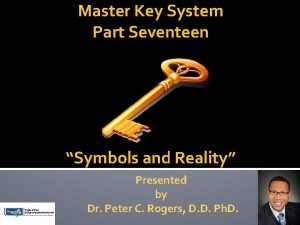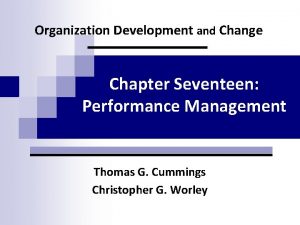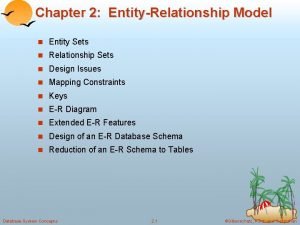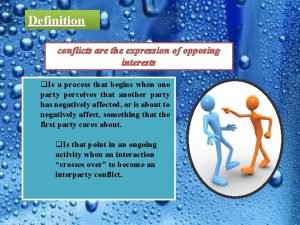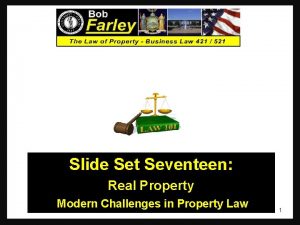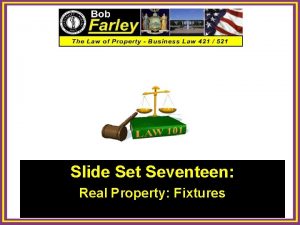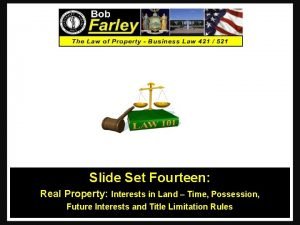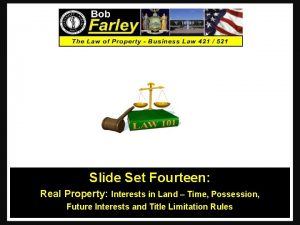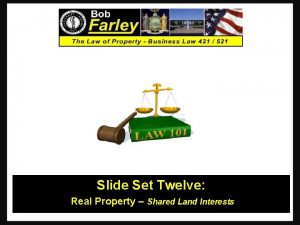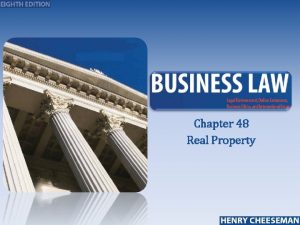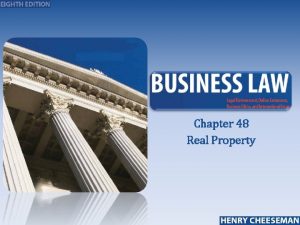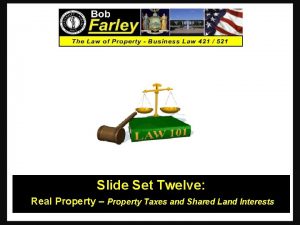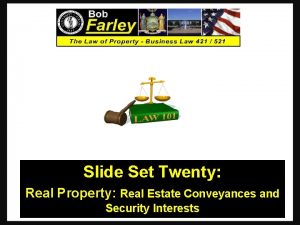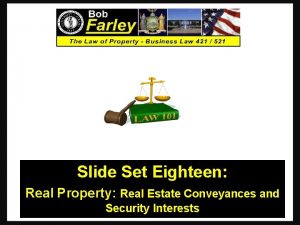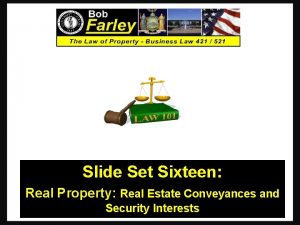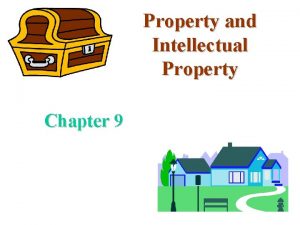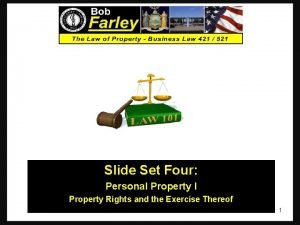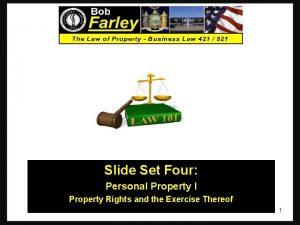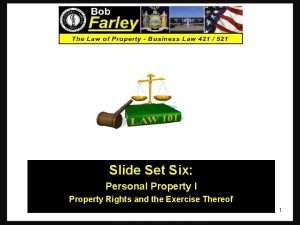Slide Set Seventeen Real Property Non Possessory Interests




























- Slides: 28

Slide Set Seventeen: Real Property: Non Possessory Interests 1

Last Time We Spoke About: • The Following: - The Nature, Definitions and Explanation of Estates in Land Possessory Interests in Land 1. Fee Simple Absolute 2. Defeasible Estates 3. Fee Tail 4. Life Estate Non possessory interests in land: 1. Easements, 2. Profits, 3. Covenants, and 4. Servitudes - Future Interests - Estates in Time 1. Life Estates, 2. Possibility of Reverters, and 3. Rights of Re-Entry - Title Limitation Rules - Rule in Shelley’s Case - Doctrine of Worthier Title - Rule Against Perpetuities - Rule Against Restraints on Alienation 2

Tonight We Will Speak About: • We Will Discuss: - Non Possessory Interests - Easements - Profits - Covenants - Servitudes 3

Non Possessory Interests 4

Non Possessory Interests: Differences Between Possessory and Non Possessory Interests Until now we have discussed “Possessory Interests”. Possessory Interests are interests in Real Property that either are, or will be (as in the case of pre-vested interests) possessed by the holder of the property. Just as there are possessory interests in Real Property where possession is not effectuated yet, because of time or condition, the law also recognizes interests in Real Property where the holder of such interest does not EVER actually possess the Real Property. These interests are deemed ”Non Possessory Interests” 5

Non Possessory Interests There are Four Types of Non Possessory Interests: • • Easements Profits Covenants Servitudes 6

Non Possessory Interests Types of Non Possessory Interests – Similarities and Differences • Easements, profits, covenants, and servitudes are all Non Possessory interests in land. • They create a right to use land that is possessed by someone else. • Easements, profits, covenants, and servitudes have many similarities, in operation, coverage, creation and termination. • They also have several important differences, mainly in the requirements that must be met for their enforcement. 7

Non Possessory Interests: EASEMENTS • The first type of Non Possessory Interest in Real Property is called an Easement. • An Easement is defined as: “The right to use a tract of land for a specific purpose”. • There are Four Types of Easements: - Affirmative - Negative, - Appurtenant - In Gross. 8

Non Possessory Interests: EASEMENTS – Just What are They? • As set forth previously, the holder of an easement has the right to use a tract of land (called the servient tenement) for a special purpose, but has no right to possess and enjoy the tract of land. • The owner of the servient tenement continues to have the right of full possession and enjoyment subject only to the limitation that he cannot interfere with the right of special use created in the easement holder. • Typically, easements are created in order to give their holder the right of access across a tract of land, such as the privilege of laying utility lines, or installing and maintaining such things as sewer pipes. • Easements are either affirmative or negative, appurtenant or in gross. 9

Non Possessory Interests: EASEMENTS – Types of Easements Affirmative Easements • The first type of Easement is an Affirmative Easement. • These Easements grant the holder the right to enter upon the servient tenement and make an affirmative use of it for a specific purpose. • They permit the holder to make a use of the servient estate that, absent the easement, would be an unlawful trespass or nuisance. • Examples of Affirmative Easements include: - Laying and maintaining utility lines, draining waters, or utilizing airspace over the servient estate. - A right-of way easement, permitting the holder to travel over the servient estate. 10

Non Possessory Interests: EASEMENTS – Types of Easements Negative Easements • The second type of Easement is a Negative Easement. • These Easements grant the holder the right to PREVENT the possessory owner from doing a specific activity with the servient tenement. • These Easements act, in effect, as a restrictive covenant. • Courts hesitate to recognize new forms of negative easements and generally have confined them to a traditional handful, such as, Easements that protect light, air, subjacent or lateral support, and the flow of water. • Examples of Negative Easements include: - Preventing the construction of a Lake view obstructing fence or structure. - Preventing the removal or obstruction of a local storm drainage system. 11

Non Possessory Interests: EASEMENTS – Types of Easements Easement Appurtenant • The third type of Easement is an Easement Appurtenant. • These Easements grant a land owner of one tract the right of special use benefits of his physical use or enjoyment of another tract of land. • For an easement appurtenant to exist, there must be TWO tracts of land: - The dominant tenement, which has the benefit of the easement, and The servient tenement, which is subject to the easement right. • Easements appurtenant pass with transfers of the benefited land, regardless of whether the easement is mentioned in the conveyance. • Example: A owns Lot 6 and B owns Lot 7. These lots are adjoining tracts of land. By a written instrument (the easement appurtenant), B grants to A the right to cross B's tract (Lot 7). A's use and enjoyment of his land (Lot 6) is benefited by virtue of the acquisition of the right to use B’s land (Lot 7) for this special purpose. The right is an easement appurtenant. B remains the owner of Lot 7. A has only a right to use Lot 7 for a special purpose, (i. e. , the right to cross the tract). 12

Non Possessory Interests: EASEMENTS – Types of Easements Easement in Gross • The fourth type of Easement is an Easement in Gross. • These Easements are created where the holder of the easement interest acquires a right of special use in the servient tenement independent of his ownership or possession of another tract of land. • With this Easement, the holder is not benefited in his use and enjoyment of a possessory estate by virtue of the acquisition of that privilege. • With an Easement in Gross, there is no dominant tenement. • An Easement in Gross passes entirely apart from any transfer of land. Example: A owns Lot 6. By a written instrument, he grants to B the right to build a pipeline across Lot 6. B receives the privilege independent of his ownership or possession of a separate tract of land. B has acquired an easement in gross. Easements in gross can be either personal (e. g. , 0 gives friend right to swim and boat on lake) or commercial (e. g. , utility or railroad track easements). Generally, an easement in gross is transferable only if the easement is for a 13 commercial or economic purpose.

Non Possessory Interests: EASEMENTS – Types of Easements Appurtenant vs. Easement in Gross • Easements Appurtenant are given judicial preference. • If an easement interest is created and its owner holds a possessory estate that is, or could be, benefited in physical use or enjoyment by the acquisition of the privilege, the easement will be deemed appurtenant. • This is true even though the deed creating the easement makes no reference to a dominant tenement. Example: A conveys to "B, her heirs, successors, and assigns, the right to use a strip 20 feet wide on the north edge of Blackacre for ingress and egress to Whiteacre. " Because there is ambiguity as to whether the benefit was intended to attach to B's land, (Whiteacre) or to B personally, a court will apply the constructional preference and hold that the benefit was intended to be appurtenant. As a result, any conveyance of Whiteacre by B will carry with it the right to use the strip across Blackacre. 14

Non Possessory Interests: EASEMENTS – Creation of Easements The basic methods of creating an easement are: • • Express grant Express reservation Implication, and Prescription. 15

Non Possessory Interests: EASEMENTS – Creation of Easements Express Grant: • An Easement can be created by an express grant, accomplished by the delivery of a written document, signed by the grantor. • Because an Easement is an interest in land, the Statute of Frauds applies (written instrument signed by the party to be charged). • A grant of an Easement must comply with all the formal requisites of a deed. • An Easement is presumed to be of perpetual duration unless the grant specifically limits the interest (e. g. , for life, for 10 years). 16

Non Possessory Interests: EASEMENTS – Creation of Easements Express Reservation: • An Easement by Reservation arises when the owner (of a present possessory interest) of a tract of land conveys title but RESERVES the right to continue to use the tract for a special purpose after the conveyance. • In effect, the grantor passes title to the land but RESERVES unto himself, through the deed, an easement interest. • Note, that in most states, an Easement can only be reserved for the grantor. As a result, any attempt by the grantor to reserve an Easement for anyone else is deemed void. 17

Non Possessory Interests: EASEMENTS – Creation of Easements Implication: • An Easement by Implication is created by operation of law rather than by written instrument. • It is an exception to the Statute of Frauds. • There are only two types of Implied Easements: 1. An intended easement based on a use that existed when the dominant and servient estates were severed, and 2. An easement by necessity. 18

Non Possessory Interests: EASEMENTS – Creation of Easements Prescription: • • • Acquiring an Easement by Prescription is analogous to acquiring property by adverse possession. To acquire a Prescriptive Easement, the use of the Easement must be continuous, open, actual, under a claim of right, hostile and notorious. Since Easements by their nature are upon non possessed lands, exclusivity does not apply. The public at large can acquire a Prescriptive Easement in private land if members of the public use it in a way that meets the requirements for prescription. Negative easements cannot arise by prescription, nor generally may easements involving public lands. An easement by necessity cannot give rise to an easement by prescription. However. if the necessity ends, so does the easement, and an adverse use can, over time, create an easement by prescription. 19

Non Possessory Interests: EASEMENTS – Termination of Easements • An easement, like any other property interest, may be created for a duration of perpetuity or for a limited period of time. • To the extent the parties to its original creation provide for the natural termination of the interest, such limitations will control. • Release - An easement may be terminated by a release given by the owner of the easement interest to the owner of the servient tenement. A release requires the concurrence of both owners, and is, in effect, a conveyance. The release must be executed with all the formalities that are required for the valid creation of an easement. It must be in writing in order to satisfy the Statute of Frauds. An oral release is ineffective, although it may become effective by estoppel. • Abandonment - It has become an established rule that an easement can be extinguished without conveyance where the owner of the privilege demonstrates by physical action an intention to permanently abandon the easement. To work as an abandonment, the owner must have manifested an intention never to make use of the easement again. 20

Non Possessory Interests: PROFITS – Generally: • A Profit, like an Easement, is a nonpossessory interest in land. • A Profit is a commercial relationship in real property whereby: “The holder of the Profit is entitled to enter upon the servient tenement to which the profit applies, and take the soil or a substance of the soil from the real property” • Profits usually involve minerals, timber, oil, or game. • A Profit may also be appurtenant or in gross. • Unlike Easements, however, there is a constructional preference for Profits in gross rather than appurtenant. 21

Non Possessory Interests: PROFITS – Elements: 1. Creation - Profits are created in the same way as easements. 2. Alienability - A profit appurtenant follows the ownership of the dominant tenement and a profit in gross may be assigned or transferred by the holder. 3. Exclusive vs. Nonexclusive Profits - Profits may be granted for exclusive use by the grantee, or non exclusive use for the grantee and others. Ordinarily, profits (like easements) are construed as nonexclusive. 4. Scope - The extent and nature of the profit is determined by the words of the express grant (if there was a grant), or by the nature of the use (if the profit was acquired by prescription). Implied in every profit is an easement entitling the profit holder to enter the servient estate to remove the resource. 5. Termination - Profits are terminated in the same way as easements. 22

Non Possessory Interests: COVENANTS – Generally: • A Covenant Running With The Land at Law is defined as: “A written promise (normally found in a deed) to do something on the land or a promise not to do something on the land”. • A covenant, normally found in deeds, is a written promise to do something on the land (e. g. maintain a fence) or a promise not to do something on the land (e. g. , conduct commercial business). • Covenants run with the land at law, which means that subsequent owners of the land may enforce or be burdened by the covenant. • To run with the land, however, the benefit and burden of the Covenant must be analyzed separately to determine whether they meet the requirements for running. 23

Non Possessory Interests: COVENANTS – Termination: • • As with all other nonpossessory interests in land, a Covenant may be terminated by: (i) the holder of the benefit executing a release in writing; (ii) merger (fee simple title to both the benefited and burdened land comes into the hands of a single owner); and (iii) condemnation of the burdened property. 24

Non Possessory Interests: EQUITABLE SERVITUDES – Generally: • An Equitable Servitude is defined as: “A Covenant that, regardless of whether it runs with the land at law, will be enforced in equity against the assignees of the burdened land who have notice of the covenant”. • The usual remedy for a violation of an Equitable Servitude is specific performance of the covenant, or an injunction against its violation. Creation • Generally, Equitable Servitudes are created by covenants contained in a writing that satisfies the Statute of Frauds. • As with Covenants, acceptance of a deed signed only by the grantor is sufficient to bind the grantee as promisor. Enforcement • For successors of the original promisee and promisor to enforce an Equitable Servitude, certain requirements must be met (Running). 25

Non Possessory Interests: EQUITABLE SERVITUDES – Generally: Requirements for Burden to Run with the Land: • • • 1) Intent - The covenanting parties must have intended that the Equitable Servitude be enforceable by and against assignees. Such intent may be ascertained from the purpose of the Covenant and the surrounding circumstances. 2) Notice - A subsequent purchaser of land burdened by a Covenant is not bound by it in equity unless he had actual or constructive notice of it when he acquired the land. 3) Touch and Concern – As with covenants, the restriction of the Equitable Servitude must directly involve and concern the real property. When the Benefit Will Run - The benefit of the Equitable Servitude will run with the land (and thus to successors in interest) if the original parties so intended and the servitude touches and concerns the benefited property. Privity Not Required – Most courts now enforce the Servitude not as an in personam right against the owner of the servient tenement, but as an equitable property interest in the land itself. There is, therefore, no need for privity of estate. 26

Non Possessory Interests: EQUITABLE SERVITUDES – Generally: Equitable Defenses to Enforcement: • A court in equity is not bound to enforce an Equitable Servitude if it cannot in good conscience do so. Defenses include: a. Unclean Hands b. Acquiescence c. Estoppel d. Changed Neighborhood Conditions e. Zoning Termination: • Like other nonpossessory interests in land, an Equitable Servitude may be terminated by: 1. A written release from the benefit holder(s), 2. Merger of the benefited and burdened estate, or 3. Condemnation of the burdened property. 27

• Bonus Questions of the Day For next time – Read Assignmen on the Webpage. • Questions? ? ? 28
 Non possessory estate
Non possessory estate Dance moms seventeen magazine
Dance moms seventeen magazine Seventeen symbols
Seventeen symbols Parfoy
Parfoy Seventeen table
Seventeen table Heel and toe heel and toe slide slide slide lyrics
Heel and toe heel and toe slide slide slide lyrics Total set awareness set consideration set
Total set awareness set consideration set Training set validation set test set
Training set validation set test set Un merveilleux sauveur est christ mon seigneur lyrics
Un merveilleux sauveur est christ mon seigneur lyrics Commutative property vs associative property
Commutative property vs associative property Sapratibandha
Sapratibandha Chemical and physical properties
Chemical and physical properties The entity set is a *
The entity set is a * Interests outside of school
Interests outside of school Difference between hobby and interest
Difference between hobby and interest Difference of interest and hobbies
Difference of interest and hobbies Unifrog interests quiz
Unifrog interests quiz Stakeholders and their interests
Stakeholders and their interests Hobbies conversation questions
Hobbies conversation questions What do you usually do when you have free time
What do you usually do when you have free time Executory interest examples
Executory interest examples Opposing interests
Opposing interests Tiny rascal gang
Tiny rascal gang Difference between interests and hobbies
Difference between interests and hobbies She doesn't like playing football
She doesn't like playing football Describing hobbies and interests
Describing hobbies and interests Hobbies and interests of a teacher
Hobbies and interests of a teacher Spiritual interests
Spiritual interests Slide and divide steps
Slide and divide steps


